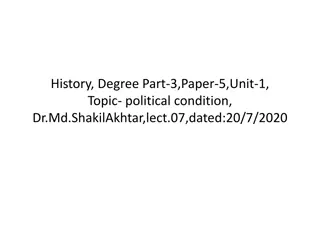State Bank of India
State Bank of India (SBI) is one of the largest and pioneer public sector banks in India. It was established in 1806 as the Bank of Calcutta, making it one of the oldest commercial banks in the Indian subcontinent. It later merged with the Bank of Bombay and the Bank of Madras in 1921 to form the Im
4 views • 5 slides
Indian Ringneck Parrots For Sale Near Me - megabirdstores.com
Indian Ringneck Parrots For Sale Near Me, with their vibrant plumage and playful personalities, are among the most popular pet birds worldwide. Originally hailing from the Indian subcontinent, these charming birds have captured the hearts of bird enthusiasts around the globe. \nText\/ WhatsApp: 1 (
1 views • 4 slides
Understanding Shamilat-e-Deh: Common Village Land Ownership in Pakistan
Shamilat-e-Deh refers to common village land in Pakistan jointly owned by landowners for community purposes. This traditional system dates back to British rule in the subcontinent and involves shared ownership of resources like mosques, schools, and grazing lands. Landowners' shares in Shamilat are
1 views • 16 slides
War of Independence 1857: Causes, Impact, and Failure
The War of Independence in 1857 was a pivotal moment in the history of the Indian subcontinent, fought against British domination. Despite efforts by Indians, including issues of conflict and lack of leadership, the war ultimately failed due to various political, social, religious, military, and eco
0 views • 22 slides
Effects of First World War on Subcontinent
World War I, also known as the Great War, had significant negative impacts on the Indian subcontinent. Indians faced difficulties on the home front due to massive recruitment efforts, high taxes, and price hikes. The war led to a drain of wealth, food shortages, and a fall in the standard of living.
0 views • 7 slides
Rise of Janapadas and Mahajanapadas in Vedic India
The rise of Janapadas and Mahajanapadas marked a significant transition in the political landscape of Vedic India. Janapadas, major kingdoms of that era, evolved into more powerful Mahajanapadas through territorial expansion and urbanization. The shift from tribal polities to territorial states led
0 views • 9 slides
Exploring the Historical Developments from 700 to 1750
The study of history between 700 and 1750 presents a vast array of challenges due to the diverse technological advancements, cultural shifts, and societal changes that occurred during this period. Historians rely on a variety of sources, such as coins, inscriptions, and manuscripts, to understand th
0 views • 11 slides
All You Need to Know About Hilsa Fish
Hilsa herring, also known as Hilsa shad, is a sought-after food fish in the Indian Subcontinent, particularly in Bangladesh, India, and West Bengal. This marine species belongs to the herring family, Clupeidae, and can grow up to 60cm in length. It is an anadromous fish, schooling in coastal waters
0 views • 5 slides
Political Turmoil in Pre-Babur India
Babur, a Turkic ruler, seized power in India in the early 16th century amidst a chaotic political landscape. With weak rulers in Delhi and conflicting powers across the subcontinent, Babur's successful invasion marked a significant shift in Indian history, leading to far-reaching consequences.
0 views • 8 slides
The British Expansion in India: From Trade to Territory
The journey of the British in India from establishing trade through the East India Company to gaining territorial control is explored. The narrative covers the company's strategic moves, conflicts with local rulers, and pivotal events such as the Battle of Plassey that shaped British dominance over
0 views • 16 slides
Developing and Administering a DBE Program for Small Businesses
The Disadvantaged Business Enterprise (DBE) Program aims to support small businesses owned by socially and economically disadvantaged individuals. These individuals belong to various groups such as Black Americans, Hispanic Americans, Native Americans, Asian-Pacific Americans, Subcontinent Asian Ame
1 views • 16 slides
Influence of Indian English in "The Jewel in the Crown" by Rochana Jayasinghe
Indian English plays a significant role in the Indian subcontinent with 200 to 333 million English speakers. India is a key player in the English language landscape, publishing more books in English than any other language. The British Raj from 1858 to 1947 shaped the prominence of English in India,
0 views • 18 slides
The Rise of New States and Hindu Principalities in Decline of the Mughal Empire
During the later Mughal period, provincial governors gained independence, laying the foundation for new dynasties in regions like Oudh, Bengal, and South. The rise of Hindu states, including Rajputs and Sikhs, contributed to the disintegration of the Mughal Empire. Governors like Saadat Khan Burhan-
0 views • 8 slides
War, Violence, and Women in Subcontinent Partition Fiction: A Literary Analysis
This research work delves into the portrayal of gynocentric perspectives focusing on women as victims in the works of female novelists from South Asia regarding the India-Pakistan Partition and the Bangladesh War. The study examines six novels by authors such as Jyotirmoyee Devi, Attia Hosain, Mumta
0 views • 34 slides
Consolidated Shipping Services LLC: Project Logistics Expertise Since 2012
UAE THLG member since 2012, Consolidated Shipping Services LLC specializes in project logistics management for various industries such as oil & gas, petrochemical, industrial projects, and more. Their services include monitoring purchase orders, on-site supervision, technical planning for heavy lift
0 views • 5 slides
Overview of the Mughal Empire and Its Great Mughals
The Mughal Empire was a significant imperial power in the Indian subcontinent from 1526 to 1757, ruled by Muslim descendants of Genghis Khan. The empire extended over a vast region and produced six great Mughal rulers: Babur, Humayun, Akbar, Jahangir, Shah Jahan, and Aurangzeb. Babur was the founder
0 views • 14 slides















